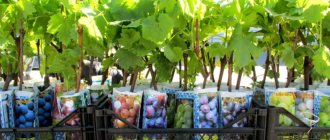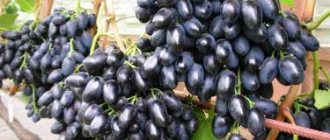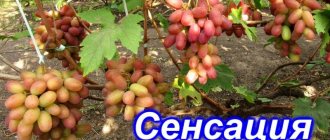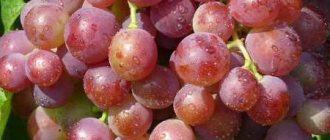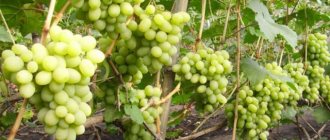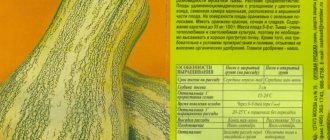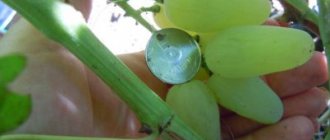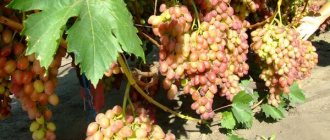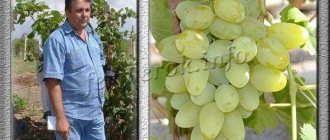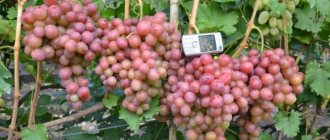Fruits and berries » Grapes
0
931
Article rating
Kira Stoletova
Grapes have a large range of vitamins and microelements necessary for both adults and children. To grow Sponsor grapes and get high yields from a bush, you should familiarize yourself with its main qualities and care nuances.
Growing grapes Sponsor
What type does it belong to?
Sponsor - table hybrid subspecies of white grapes . The ripening period is early (although the author declares it to be super-early), the harvest ripens around mid-August.
It is stored satisfactorily (subject to proper conditions), remains on the bush for a long time, has an excellent presentation, and tolerates transportation well.
As a rule, it is used fresh; we love it for its rich taste with nutmeg and citrus notes in the aftertaste. Also good for compotes, jams, liqueurs. It is also used in bouquets of white wines.
White table hybrids also include Aladdin, Alexander and Blagovest.
Caring for these grapes
Planting vines
- Site selection. Sponsor is light- and heat-loving, so it is better to plant it in the southern half of the yard. It is important not to plant grapes in the lowlands - on the contrary, they will like the raised bed. The Sponsor's roots are afraid of excess moisture; because of it, the vine will grow more slowly and the development of the plant will slow down.
- Time. It is better to plant grapes in the spring, but prepare the hole in the fall.
- Planting pit. Dig a hole 70x80 cm wide and long. Depth - 70 cm. Mix the excavated soil with compost in a 1:1 ratio.
Grapes "Sponsor": description of the variety
The growth of the bush is very large. The bunch is large, weighing up to a kilogram, moderately loose, cone-shaped. It may pea.
The berries are large, 12-13 g, oval, golden-amber in color, sometimes with a greenish tint.
The skin is dense, of moderate thickness, edible. The pulp is dense, juicy, with a rich nutmeg flavor; inside there are two clearly noticeable full-fledged seeds.
The stalks are light green, strong, relatively long. The ripened shoot is golden brown, covered with reddish nodes. The ovary is dense, pale green. Flowers of both sexes.
Moldova, Count of Monte Cristo and Galbena Nou also have bisexual flowers.
The leaves are dark green, round, large, medium-cut.
Basic landing rules
It is advisable to plant grapes of this variety on the south side of the garden plot; they love bright sun and warmth. It is better to place the seedling on a small mound to prevent the accumulation of cold air, which contributes to slower growth and the development of fungal diseases.
- When planning spring planting, you need to prepare the holes in the fall.
- Dig a hole measuring 80*80*80.
- Mix 2 buckets of dug up soil with 2 buckets of compost and pour back into the hole.
- If groundwater flows nearby, drainage is done.
- If planting is planned in the fall, then all the same actions are performed a month before planting the seedling.
- A day before planting, lightly trim the roots of the seedling and place it in water.
- The next day, the seedling is lowered into the hole, the roots are straightened and covered with earth.
- Water generously on top.
Sources:
https://fermoved.ru/vinograd/sponsor-opisanie-sorta.html https://sornyakov.net/berries/vinograd-sponsor.html https://provinograd.com/sorta/sponsor.html
Photo
Appearance of the Sponsor grapes in the photo below:
Useful video
You can get acquainted with the Sponsor grapes in more detail in the video below:
If you find an error, please select a piece of text and press Ctrl+Enter.
While I was going to the city for a session, my husband, who was vacationing at the dacha, decided to do something nice for the family. I bought grapes and planted an empty plot. I always thought that this plant requires a lot of water, so I was upset: it would die on our hill... But the grapes took root, and two years later we were pleased with the first harvest.
History of selection
The variety was created by the Ukrainian breeder E. P. Pavlovsky. “Dad and Mom” - Talisman and Sprinter.
The originator set out to create a nutmeg form that would be stable and would not require much effort.
Now the Sponsor is in the testing stage, but the existing results indicate that the breeder has completed his task.
It is taking root well throughout Ukraine and the south of the former Union; it is too early to talk about the central zone.
The hand of the same breeder belongs to Romeo, Zarya Nesvetaya and Pharaoh.
Let's summarize
- The sponsor is a hybrid grape of Ukrainian selection, which can be grown throughout Ukraine, in the south of Russia or Belarus.
- The plant has many advantages: it is not afraid of cold and diseases (including fungal ones), the harvest is easily transported and stored, the berries have a pleasant nutmeg taste and aroma.
- It is better to grow this variety in the southern part of the yard, on a hill (the roots of the grapes are afraid of groundwater). The harvest will be early and can be collected as early as August.
You will hear more information about muscat grapes here. In addition, you will find out why nutmeg is called nutmeg, as well as which varieties of this subgroup are considered the best:
Characteristics
Sponsor grapes are very resistant to fungal diseases, slightly less resistant to parasites , in particular phylloxera.
There is no specific data on frost resistance yet; the preliminary figure given is 22-23 degrees Celsius. Requires permanent shelter for the winter months .
Doesn't get along well with rootstocks. The color does not fall off even in rainy years, but it is afraid of hail. The vine ripens along almost the entire length of the growth. The percentage of sugar content does not rise above 18-20 Brix. Not very resistant to wasps.
Requires standard pruning of four to six eyes.
Reviews about growing and harvesting
- Vladimir. Sponsor's berries are good - not liquid inside, they can be compared to marmalade. Juicy. The older the bush, the larger the grapes grow. And by the way, if you don’t pick the bunches on time, they will remain hanging on the bush without falling off.
- Sergey. For four years the vine grew well, but this year there was no luck - pollination took place in the rain, which caused the bush to become very weedy.
- Dasha. And in August a lot of our berries cracked. Well, at least they were no longer green, but ripe, picked for juice... I think the rains are to blame...
- Hope. The first fruiting began in the third year after planting. The bunches look very appetizing, smell like lemonade, and the child is already buzzing with all his ears. We picked some berries (plucked them while dad wasn’t looking). The seeds are small and black, the skin is practically not felt when eating. Good grapes.
And in this video, an experienced gardener will tell you about growing grapes of this variety:
Diseases and pests
If you don’t have to worry too much about powdery mildew (oidium and mildew) and various types of rot, then wasps and birds will always hunt for grapes . Feathered thieves - jays, sparrows, tits, magpies - will be stopped by a strong, inflexible network with medium-sized cells.
Scarecrows and various posters and balloons with images of scary hawk eyes, as practice has shown, do not save grapes.
Insecticides such as “OtOs” and garlic broth are good against wasps. The latter, however, has a rather weak effect and will not scare away striped predators for a long time.
You also need to collect all the nests that can be found on the site and destroy them. It would be a good idea to seal all the holes in the posts supporting the bushes - wasps simply love to settle there.
There is some debate regarding resistance to phylloxera. Some farmers say that Sponsor is not affected by it, others note cases of bushes being occupied by this parasite.
You can get rid of it only with the help of volatile carbon disulfide in a concentration of three hundred to four hundred cubic centimeters per square meter. Yes, this is dangerous for the vine, but if you “sorry” a diseased bush, the aphids will certainly spread to others.
However, there is a limit at which the parasite goes away for a long time, but the bush survives. This is 80 “cubes” per square meter.
Do not forget that in addition to powdery mildew and pests, anthracnose, bacteriosis, chlorosis, rubella and bacterial cancer are also common among grape diseases. Read about the signs of these diseases and preventive measures in separate articles on the site.
The sponsor is unpretentious, strong and very popular with customers. And it doesn’t require particularly complicated care.
You just need to take timely measures to protect the vines from phylloxera and make sure that wasps do not settle on the site. Then the Sponsor will delight you with abundant berries, which are good in compote, in a wine barrel, or simply fresh.
Among the unpretentious varieties, it is worth paying attention to Delight Ideal, Aleshenkin's Gift and Giovanni.
Features of care
The plant needs enough light
To obtain a good harvest, stable and annual, you must follow some rules of agricultural technology specific to the Sponsor. This is a sunny variety that loves light and warmth.
Landing
Bushes grow best on the south side of the garden plot. Planting is done in bulk ridges to avoid stagnation of water and to avoid fungal diseases of the root system. Excess moisture leads to slower growth and development of the bush.
The planting hole is prepared in the fall to make spring planting more successful. Its size is 70 x 80 x 70 cm. A nutritious soil mixture is prepared. To do this, mix compost and soil in equal proportions (2 buckets x 2 buckets) and pour it into the bottom of the hole.
The roots of the plant are trimmed with pruning shears or a sharp garden knife and placed in water for 24 hours before planting in the ground. After the measures have been taken, the plant is placed in a hole and covered with earth so that the neck does not end up buried in the ground. Otherwise, the vine will rot.
The earth around is compacted and watered with water at room temperature. Cold liquid shocks the plant and slows down its development for a while.
Care
Proper care involves regular and abundant watering of plants at the rate of 2 buckets once a month for each bush. The frequency of watering is determined visually; it depends on the raininess of the season. During the dry season, irrigation is carried out every 7 days.
Mineral and organic fertilizers are used for feeding. It is performed twice: in spring and autumn.
For good development of the grapes, they monitor the cleanliness of the area on which the vineyard is located. They remove and weed out all the weeds that deplete the soil and take away moisture from it.
Regular pruning is necessary to form a bush and obtain large brushes. It is carried out in spring and autumn. In late autumn, the old vine and branches on it are removed; in the spring, shoots are cut down to 4-5 buds.
Frost resistance of grapes does not mean that they do not need to be covered for the winter. This must be done by first lowering it to the ground from the trellis and tying the branches together. Any covering material will do: film, tarpaulin or burlap.

